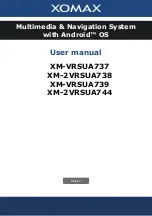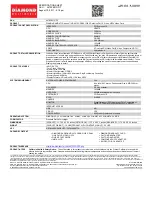
3-1
SECTION 3
ELECTRICAL ADJUSTMENT
3.1
Precaution
The following adjustment procedures are not only necessary
after replacement of consumable mechanical parts or board
assemblies, but are also provided as references to be re-
ferred to when servicing the electrical circuitry.
In case of trouble with the electrical circuitry, always begin a
service by identifying the defective points by using the meas-
uring instruments as described in the following electrical ad-
justment procedures. After this, proceed to the repair, replace-
ment and / or adjustment. If the required measuring instru-
ments are not available in the field, do not change the adjust-
ment parts (variable resistor, etc.) carelessly.
3.1.1 Required test equipments
• Color (colour) television or monitor
• Oscilloscope: wide-band, dual-trace, triggered delayed
sweep
• Digit-key remote controller (provided)
3.1.2 Required adjustment tools
Jig RCU
PTU94023B
Alignment tape
(SP, stairstep, NTSC)
MHP
Alignment tape
(EP, stairstep, NTSC)
MHP-L
Alignment tape
(SP, stairstep, PAL)
MHPE
Alignment tape
(LP, stairstep, PAL)
MHPE-L
Alignment tape
(SP, color (colour) bar, NTSC)
MH-1
Alignment tape
(EP, color (colour) bar, NTSC)
MH-1L
Alignment tape
(SP, color (colour) bar, PAL)
MH-2
Alignment tape
(LP, color (colour) bar, PAL)
MH-2L
3.1.3 Switch settings and standard precautions
The SW settings of the VCR and the standard precautions
for the electrical adjustments are as follows.
•
When using the Jig RCU, set its custom code to match
the custom code of the VCR.
• Unless otherwise specified, all measuring points and
adjustment parts are located on the Main board.
• When checking the operation or performing adjust-
ments to the VCP main unit, it is necessary to connect
the power cable (Car Cable) to the VCP main unit so
that DC power is supplied. Also, when using the re-
mote control unit, it is required to connect the IR re-
ceiver. (by using either the provided or operational ac-
cessories)
INITIAL MODE
DATA CODE
CUSTOM CODE
43: A
CODE
53: B
CODE
[Data transmitting method]
Depress the “ ” ( 3 ) button
after the data code is set.
Jig RCU
Fig. 3-1-3a Jig RCU [PTU94023B]
3.2
Servo circuit
3.2.1 Switching point
Signal
(A1)
• Stairstep signal
[KV-V8E]
(A2)
• Alignment tape (SP, stairstep, PAL) [MHPE]
[KV-V8J]
(A2)
• Alignment tape (SP, stairstep, NTSC) [MHP]
Mode
(B)
• PB
Equipment
(C)
• Oscilloscope
Measuring point
(D1)
• VIDEO OUT terminal (75
Ø
terminated)
(D2)
• TP106 (PB FM)
External trigger
(E)
• TP111 (D.FF)
Adjustment part
(F)
• Jig RCU: Code “5A”
[KV-V8E]
Specified value
(G)
• 6.5 ± 0.5 H (SP, stairstep, PAL) [MHPE]
[KV-V8J]
(G)
• 6.5 ± 0.5 H (SP, stairstep, NTSC) [MHP]
Adjustment tool
(H)
• Jig RCU [PTU94023B]
(1) Play back the signal (A1) of the alignment tape (A2).
(2) Apply the external trigger signal to D.FF (E) to observe
the VIDEO OUT waveform and V.PB FM waveform at the
measuring points (D1) and (D2).
(3) Set the VCR to the manual tracking mode.
(4) Adjust tracking so that the V.PB FM waveform becomes
maximum.
(5) Set the VCR to the Auto adjust mode by transmitting the
code (F) from the Jig RCU. When the VCR enters the
stop mode, the adjustment is completed.
(6) If the VCR enters the eject mode, repeat steps (1) to (5)
again.
(7) Play back the alignment tape (A2) again, confirm that the
switching point is the specified value (G).
Fig. 3-2-1a Switching point
V.sync
Trigger point
Switching point
V. rate
- - - - - - - - - - - - - - - - - - - - - - - - - - - - - - - - - - - - - - - - -
- - - - - - - - - - - - - - - - - - - - - - - - - - - - - - - - - - - - - - - - -
- - - - - - - - - - - - - - - - - - - - - - - - - - - - - - - - - - - - - - - - -



































